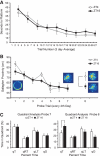Bidirectional interactions between circadian entrainment and cognitive performance
- PMID: 22383380
- PMCID: PMC3293516
- DOI: 10.1101/lm.023499.111
Bidirectional interactions between circadian entrainment and cognitive performance
Abstract
Circadian rhythms influence a variety of physiological and behavioral processes; however, little is known about how circadian rhythms interact with the organisms' ability to acquire and retain information about their environment. These experiments tested whether rats trained outside their endogenous active period demonstrate the same rate of acquisition, daily performance, and remote memory ability as their nocturnally trained counterparts in tasks of sustained attention and spatial memory. Furthermore, we explored how daily task training influenced circadian patterns of activity. We found that rats demonstrate better acquisition and performance on an operant task requiring attentional effort when trained during the dark-phase. Time of day did not affect acquisition or performance on the Morris water maze; however, when animals were retested 2 wk after their last day of training, they showed better remote memory if training originally occurred during the dark-phase. Finally, attentional, but not spatial, task performance during the light-phase promotes a shift toward diurnality and the synchronization of activity to the time of daily training; this shift was most robust when the demands on the cognitive control of attention were highest. Our findings support a theory of bidirectional interactions between cognitive performance and circadian processes and are consistent with the view that the circadian abnormalities associated with shift-work, aging, and neuropsychiatric illnesses may contribute to the deleterious effects on cognition often present in these populations. Furthermore, these findings suggest that time of day should be an important consideration for a variety of cognitive tasks principally used in psychological and neuroscience research.
Figures









Similar articles
-
Interactions between cognition and circadian rhythms: attentional demands modify circadian entrainment.Behav Neurosci. 2009 Oct;123(5):937-48. doi: 10.1037/a0017128. Behav Neurosci. 2009. PMID: 19824760 Free PMC article.
-
Chronic disruption of circadian rhythms impairs hippocampal memory in the rat.Brain Res Bull. 2008 May 15;76(1-2):141-51. doi: 10.1016/j.brainresbull.2008.02.013. Epub 2008 Mar 4. Brain Res Bull. 2008. PMID: 18395623
-
Novel object recognition of Djungarian hamsters depends on circadian time and rhythmic phenotype.Chronobiol Int. 2015 May;32(4):458-67. doi: 10.3109/07420528.2014.992526. Epub 2014 Dec 16. Chronobiol Int. 2015. PMID: 25513752
-
Cycling behavior and memory formation.J Neurosci. 2009 Oct 14;29(41):12824-30. doi: 10.1523/JNEUROSCI.3353-09.2009. J Neurosci. 2009. PMID: 19828795 Free PMC article. Review.
-
Circadian Rhythms in Attention.Yale J Biol Med. 2019 Mar 25;92(1):81-92. eCollection 2019 Mar. Yale J Biol Med. 2019. PMID: 30923475 Free PMC article. Review.
Cited by
-
The effects of seasons and weather on sleep patterns measured through longitudinal multimodal sensing.NPJ Digit Med. 2021 Apr 28;4(1):76. doi: 10.1038/s41746-021-00435-2. NPJ Digit Med. 2021. PMID: 33911176 Free PMC article.
-
Chronobiology of limbic seizures: Potential mechanisms and prospects of chronotherapy for mesial temporal lobe epilepsy.Neurosci Biobehav Rev. 2019 Mar;98:122-134. doi: 10.1016/j.neubiorev.2019.01.004. Epub 2019 Jan 7. Neurosci Biobehav Rev. 2019. PMID: 30629979 Free PMC article. Review.
-
The Cost of Activity during the Rest Phase: Animal Models and Theoretical Perspectives.Front Endocrinol (Lausanne). 2018 Mar 7;9:72. doi: 10.3389/fendo.2018.00072. eCollection 2018. Front Endocrinol (Lausanne). 2018. PMID: 29563894 Free PMC article.
-
Synchrony and desynchrony in circadian clocks: impacts on learning and memory.Learn Mem. 2015 Aug 18;22(9):426-37. doi: 10.1101/lm.038877.115. Print 2015 Sep. Learn Mem. 2015. PMID: 26286653 Free PMC article. Review.
-
Constant Light Desynchronizes Olfactory versus Object and Visuospatial Recognition Memory Performance.J Neurosci. 2017 Mar 29;37(13):3555-3567. doi: 10.1523/JNEUROSCI.3213-16.2017. Epub 2017 Mar 6. J Neurosci. 2017. PMID: 28264977 Free PMC article.
References
-
- Aguilar-Valles A, Sanchez E, de Gortari P, Balderas I, Ramirez-Amaya V, Bermudez-Rattoni F, Joseph-Bravo P 2005. Analysis of the stress response in rats trained in the water-maze: Differential expression of corticotropin-releasing hormone, CRH-R1, glucocorticoid receptors, and brain-derived neurotrophic factor in limbic regions. Neuroendocrinology 82: 306–319 - PubMed
-
- Allen PA, Grabbe J, McCarthy A, Bush AH, Wallace B 2008. The early bird does not get the worm: Time-of-day effects on college students' basic cognitive processing. Am J Psychol 121: 551–564 - PubMed
-
- Amir S, Cain S, Sullivan J, Robinson B, Stewart J 1999. Olfactory stimulation enhances light-induced phase shifts in free-running activity rhythms and Fos expression in the suprachiasmatic nucleus. Neuroscience 92: 1165–1170 - PubMed
-
- Arnold HM, Burk JA, Hodgson EM, Sarter M, Bruno JP 2002. Differential cortical acetylcholine release in rats performing a sustained attention task versus behavioral control tasks that do not explicitly tax attention. Neuroscience 114: 451–460 - PubMed
-
- Barnes CA, McNaughton BL, Goddard GV, Douglas RM, Adamec R 1977. Circadian rhythm of synaptic excitability in rat and monkey central nervous system. Science 197: 91–92 - PubMed
Publication types
MeSH terms
Grants and funding
LinkOut - more resources
Full Text Sources
Medical
